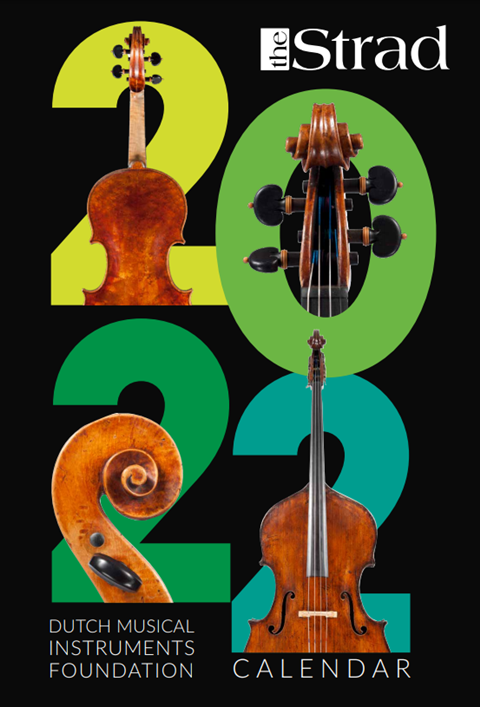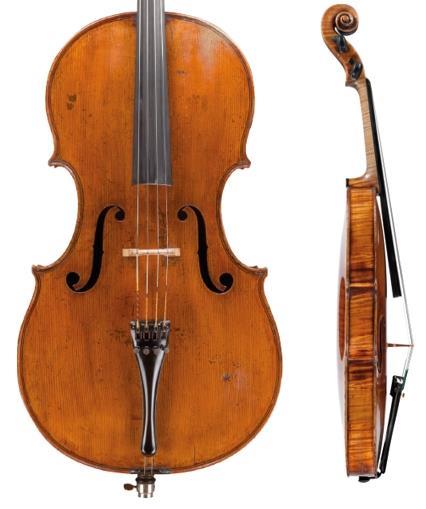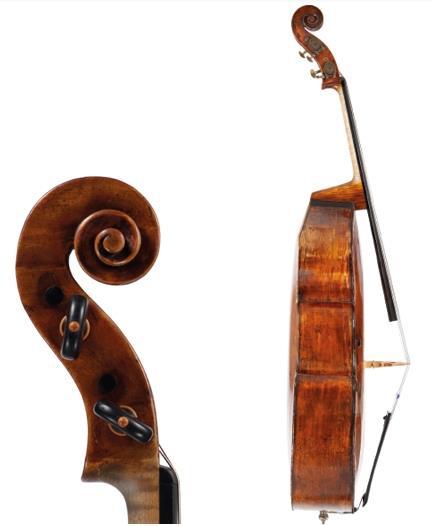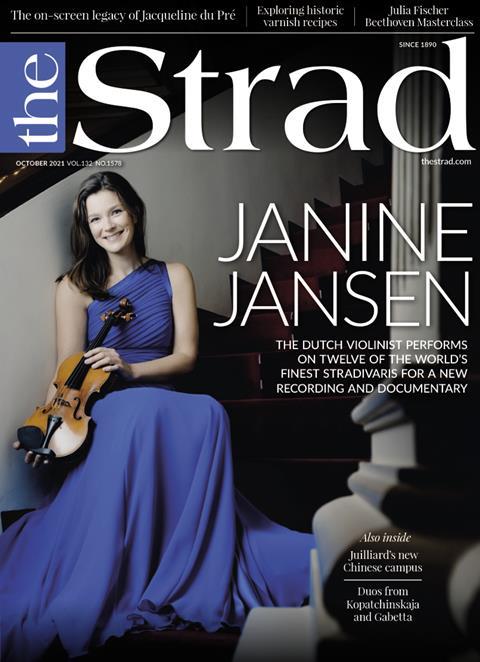The Strad Calendar 2022 showcases twelve of the finest instruments belonging to the Dutch Musical Instruments Foundation. Head of collection Frits Schutte outlines its work, while Hubert de Launay gives a tour of the riches

Since its founding in 1988, the Dutch Musical Instruments Foundation (in Dutch the ‘Nationaal Muziekinstrumenten Fonds’, or NMF) has become a pillar of Dutch musical culture. So far, around 2,500 musicians have been given access to an instrument that will hopefully inspire them to develop their talents and careers in the best possible way. An average of more than 400 musicians play on an instrument (and/or a bow) from the NMF on a long-term loan. There are musicians with an NMF instrument in almost all the Netherlands’ leading orchestras, ensembles and chamber music groups. Those instruments travel all over the world.
The NMF was initially a private initiative, founded by the father of a talented young violinist. During the search for an instrument for his daughter he came to realise that for many musicians the purchase of a suitable instrument was completely out of reach. Since then, its support has expanded to encompass a large range of musicians: from very young, talented students to experienced professionals, regardless of their nationality, age, music genre or performance practice. The only condition is that they remain connected to Dutch musical life as a professional performing artist, and as long as a suitable instrument is out of their own reach.
With over 500 instruments and 250 bows, the NMF has probably the largest ‘playing collection’ of musical instruments in Europe. Although stringed instruments are at the core, it has grand pianos, fortepianos, harps, classical guitars and several valuable percussion and wind instruments as well. Thirty per cent of its instruments and sixty per cent of bows are by contemporary makers, and we have had completely new instruments made in collaboration with forward-thinking musicians and luthiers. A five-stringed cello, a giant harp and a metal pan flute are a few examples.
The NMF is also very proud of the collection of 40 rare violins, violas and cellos from the golden age of Dutch violin making. One of our objectives is to prevent this rich cultural heritage from disappearing abroad, owing to the increasing popularity of early Dutch makers. The selection for the calendar reflects the diversity of the NMF collection.
The oldest instrument in this year’s calendar is a 1696 cello by the Dutch maker Hendrik Jacobs. For decades it was assumed that Jacobs’s stepson Pieter Rombouts was responsible for the production of cellos that left the Jacobs workshop, but recent studies have shown that Jacobs was in charge of cello making as well. This is one of the very few cellos that was made by the master himself. His hand is particularly visible in the scroll, f-holes and varnish. The long and slender pegbox with a deep, sharp throat leading into an oval volute is characteristic of the scrolls Jacobs cut in the last decade of his life. The round, wide f-holes with slender wings are cleanly cut with much more open stems than seen in Rombouts’s own cellos. Jacobs’s varnish colours varied a lot throughout his career but around the end of the century he made some instruments with a transparent golden-yellow varnish. The cello still retains its original label and has a double, hand-drawn, line around the edge of the paper; a decoration detail that only appears on Jacobs cellos. The cello has a surprisingly well-documented history from 1910 onwards, which is very rare for Dutch instruments. This was because the cello stayed within one family for a century! In 2010 the NMF had the opportunity to buy the cello and loaned it to Harriet Krijgh, who played the Jacobs when she won the 2012 competition of the Amsterdam Cello Biënnale.

The 1715 cello by Giuseppe Guarneri ‘filius Andreae’ must be the most impressive Cremonese cello in terms of maker’s marks. Particularly the slab-cut maple back, with its knots and some twisty grain, is a sight to behold. It still retains its original length of 774mm and is fully covered in (tooth)plane marks, leaving a pattern that shows the method and efficiency by which Giuseppe made this cello. This flow of work continues in the scroll and to a lesser extent in the front, where he cleaned some of the toolmarks with a scraper. The edgework and corners on this cello are still crisp and, together with the knife marks, form a ‘guidebook’ for future violin makers on how to make classical Cremonese edges. This cello has been passed down from teacher to student over the past few decades, starting with French cellist André Navarra, after whom the cello is named. In 1998, cellist Quirine Viersen came to the NMF asking whether it would be possible for it to acquire this cello for her. At that time she had the instrument on loan from her teacher, Heinrich Schiff, who in turn had acquired it from his teacher Navarra. With the help of several Dutch foundations the NMF was able to buy this magnificent cello in 1998 and it has been in Viersen’s talented hands ever since.
In 2011 the NMF had the opportunity to buy a c.1716 Antonio Stradivari violin from the Oskar Back Foundation collection, which had been loaning it to the winner of the annual Nederlands Vioolconcours. The years 1715 and 1716 are often seen as Stradivari’s peak, with such fine examples as the ‘Alard, Baron Knoop’ (see page 30), and the most famous violin in existence, the ‘Messiah’. One notable feature is the angled grain when looking at the side of the scroll. Unfortunately this violin has a later front by an unknown maker. The violin is named after Paul Godwin, who in 1933 fled Germany for the Netherlands and ended up playing in several ensembles. The crowning achievement of his career is a concert he gave in Amsterdam in November 1972, when he played the viola part in Mozart’s Sinfonia concertante together with Yehudi Menuhin and the conductor Anton Kersjes.
In 1717 Pietro Guarneri of Venice, the older brother of Guarneri ‘del Gesù’, left Cremona for the east-coast city where he remained for the rest of his life. A reason for his early departure could be that Cremona was dominated by the Stradivari workshop, while Venice had a rich musical culture with many well-known makers. The model of this 1725 violin is slightly long, with a back length of 357mm, and this elongated look is enhanced by the long and fluid f-holes. The smaller upper eye and wing flow smoothly down towards the much larger eye with a broader pointed lower wing. The scroll is very wide with the often-copied characteristic small gouge marks appearing as it enters the second turn, leading all the way up to the eye. This violin is the most expensive ever bought by the NMF, and owes its name ‘Reine Elisabeth’ to Queen Elisabeth of Belgium, who died in 1965. The violin had been in the possession of Carlo van Neste, a Belgian violinist of world fame, for the past decades. Queen Elisabeth made the money for the violin available to Van Neste ‘out of friendship and gratitude’.
Three years after the NMF was founded, it was able to purchase a 1734 Gennaro Gagliano cello from the Röntgen collection. The cello had been owned by the Röntgen family since 1914 and was played by Engelbert Röntgen, solo cellist of the Metropolitan Opera in New York, and later by his half-brother Edvard Röntgen. The cello is made from rather sober wood with an uneven flamed maple back and a spruce front carved from a coarse-grained blank which starts quarter-sawn at the centre but quickly flows into a rift-sawn cut ending in extremely wide grain in the lower wings with nearly 10mm between the growth rings. Where his father Alessandro made more classical instruments of bigger proportions with a rich oil varnish, Gennaro and his brother Nicolò opted for a deeply coloured varnish with less texture, although still of excellent quality. Gennaro was the most versatile maker in the family but his scroll, made from a practically plain piece of maple, is a perfect example of the Neapolitan style, which shows his exceptional woodworking skills. Its straight-up pegbox with an evenly concentric spiral which is protruding outwards makes it the eye-catcher of this cello.

The c.1736 violin by Giuseppe Guarneri ‘del Gesù’ is the NMF’s crown jewel. It came, together with 16 bows and 4 other instruments from the Max Rodriguez collection and, after a loan period of five years, in 1997 nearly the entire collection was donated to the NMF. It’s still the largest donation it has ever received. The model is very similar to the 1736 ‘Pasquier’ and is slightly shy in its back length at 351mm, like other instruments in this period. The same can be said about the sharp-looking f-holes. They are similar but ever so slightly narrower than those of the 1738 ‘Kemp’. The scroll, which shows the hand of his father, is made from a plainer maple and very classical; quite gentle compared to the wild and eccentric scrolls that were about to come in the last few years of his life. Unfortunately the edgework is worn and has lost its ‘crispness’ for which he is known, but the handsome, deeply reflective and broadly flamed maple back makes up for that.
The 1750 G.B. Guadagnini is a perfect example of a small-bodied cello with a back length of only 718mm. The lack of size is compensated by its depth, a strong and full arching with less hollowed edges and a broad outline, particularly around the chest area with widely set C-bouts and f-holes. When Guadagnini arrived in Milan in 1749 he started using an intense reddish-brown varnish, which this cello has to spare on the coarse-grained one-piece back. The later head is of equally small proportions and shows plenty of character in its design and execution. This cello also came to the NMF from the Max Rodriguez collection and was bought in 1993 but with one condition: it should always be strung with gut strings.

Santo Serafin had his own style within the Venetian school: controlled, cleanly finished surfaces with a varnish colour and texture that differ from those of his local fellow violin makers. Where the Venetian school is famed for its dark craquelure, Serafin had a variety of colours ranging from a pale golden yellow to the transparent reddish-brown tint seen on this 1750 violin, which is laid over bird’s-eye maple back and ribs, a choice of material often used by Serafin. His refined style and taste for delicate finishing touches is particularly seen on the scroll, which starts flat at the pegbox but flows into an expressive, full and round volute with deep cuts that end with a sharp ‘hook’ in the eye. The spine lies lower than the precisely chamfered edges, amplifying the articulate look. These refined details are a contrast with the hefty edges found on his bodies, particularly on his cellos which can be over 7mm in some places.
The Michele Angelo Bergonzi violin has a one-piece beech back with the alignment pins placed well inside the purfling. The use of beech is often looked on as an economical choice but it has been selected by some of the best classical makers such as ‘del Gesù’, Rugeri, Testore and the Dutch maker Rombouts. Although the back is plain, the medullary rays cause the appearance to change dramatically in the light. Bergonzi used plain maple for the ribs but opted for a beech scroll with widely projected eyes, a feature made famous by his father Carlo. This violin echoes the work of his father’s ‘Sandler’ and the 1744 ‘Eddy Brown’ as well. The front is made by his nephew Carlo Bergonzi II, and dates from c.1790. The widely spaced f-holes with open stems and small triangular nicks are less refined then you’d see in previous Bergonzi generations. For 53 years this violin was played by Herman Krebbers, concertmaster of the Concertgebouw. When he decided to part ways with the violin, his wish was for it to remain in the Netherlands so he would not ‘see it disappear somewhere internationally’. The NMF considers itself very lucky to have added this to its collection.

The c.1770 Carlo Ferdinando Landolfi double bass is the top pick from the NMF’s bass section. Landolfi arrived in Milan around the same time as Guadagnini, perhaps drawing inspiration from his contemporary. Landolfi had a variety of styles, shapes and sizes in his repertoire, from small violins with a high arch and a full-size stop length to a larger model with a flat arch and thick lustrous oil varnish. His choice of wood follows the same pattern: from plain maple scrolls to highly flamed backs. This is fitting for the Milanese school as his predecessors, particularly the Testore family, made instruments in a similar range of quality. The straight line that runs into the corners from the upper and lower bouts is a recurring theme in Landolfi’s work, a feature found on this double bass as well. The NMF was able to buy this instrument in 2018.
Giuseppe Antonio Rocca was born in 1807 in Barbaresco, Alba, and around the age of 30 he moved to Turin and became a pupil and assistant of G.F. Pressenda. Both have a legitimate shot at claiming the title of best 19th-century Italian violin maker. Rocca had access to the 1716 ‘Messiah’ because of his contacts with Luigi Tarisio. The 1844 violin in the Calendar is clearly modelled after the most famous Stradivari violin, particularly in the stance of the f-holes. But he stayed away from making a replica, as evidenced in the scroll which has its own individual style: a narrow pegbox with a tilted head. The eye ends on both sides of the volute out of centre. This violin is made in the year that Rocca received the copper medal at the Turin exhibition.
Finally, Jean-Baptiste Vuillaume wore many hats: luthier, collector, inventor, connoisseur, businessman and dealer. He was without question the most successful French luthier and employed over 30 violin and bow makers, many of whom became successful makers in their own right. From high-quality copies of Amati, Guarneri, Maggini and Stradivari to student instruments, his workshop produced over 3,000 instruments and this 1867 viola bears the number 2686. Modelled after Stradivari with a back length of 413mm giving it perfect modern proportions, this viola is regarded as an exceptionally pure and unique specimen, partly because Vuillaume produced few violas. Unlike many of his other instruments, this viola is not antiqued and still shows crisp edgework and corners and most of its blackened chamfer around the scroll. When purchased by the NMF in 2002, the original tuning pegs and tailpiece with hand-carved decorations were still on the instrument; the NMF had the original parts replaced and preserves them in its archive.
Buy The Strad Calendar 2022
The Strad Calendar 2022 is now available to purchase from The Strad Shop:
bit.ly/3mJU2Fy
-
This article was published in the October 2021 Janine Jansen issue
The Dutch violinist performs on twelve of the world’s finest Stradivaris for a new recording and documentary. Explore all the articles in this issue . Explore all the articles in this issue
More from this issue…
- Janine Jansen’s Stradivari recording project
- The on-screen legacy of Jacqueline du Pré
- Exploring historic varnish recipes
- Juilliard’s new Chinese campus
- Duos from Kopatchinskaja and Gabetta
- The Strad Calendar 2022
Read more lutherie content here
-












































No comments yet